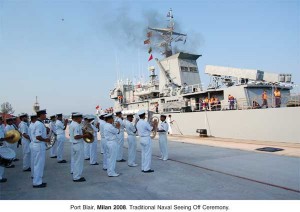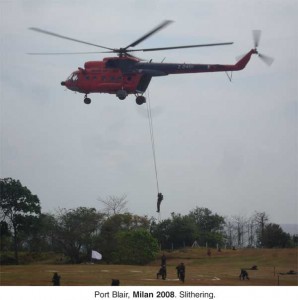It is interesting to observe that in the US context, two of the most ship innovative design decisions, the Littoral Control Ship and the conversion of the Ohio class, were thrust from above upon the US Navy. The Indian scene is different, and the Navy will have to wage a long struggle to get approval for its every proposal.
The Indian Navy has no time to lose in instituting such a process. The concept of network-centric warfare has already been studied for several years, but the task of making the navy of the future capable of it has to be addressed now if the current discourse is not to remain an academic one. A few major thrust areas could be:
- Design and production of an indigenous net platform on which the network-centric operations will be based. This would have two or three versions with differing capabilities for different classes of ships.
- Commonalisation of procedures between the Air Force and the Navy to enable joint operations followed by standardization of communication and sensor systems for networking compatibility.
- Reduction in the number of types of warships, to reduce logistic complexity and improve ship availability. The Quadrennial Defence Review of 2006 for the US Navy envisages four types of ships for a total of 143 major surface combatants. In contrast, the 21 principal surface combatants we have in the Navy today belong to seven different types.
- Institution of a programme for integration of the submarine force into the network; this will require a major effort to equip submarines with real time communication systems with minimal loss of stealth. It will also require a changed mindset in the operating philosophy of submarines wherein submarines are given the minimum essential operational intelligence and directives before deployment and thereafter left pretty much to themselves for the duration of hostilities.
- Institution of a development programme for precision guided weapons.
- Development of a modern and interoperable radar system network between all combatant units.
 This is probably a minimalist approach, and it has not considered the major efforts required in associated areas, particularly in education and training. But the point to be emphasised is an often-stated truism: it takes a lifetime to build a Navy, and if we are to transform the Navy of today into one that meets the task of (say) 2025, then the time to act is already upon us. It is interesting to observe that in the US context, two of the most ship innovative design decisions, the Littoral Control Ship and the conversion of the Ohio class, were thrust from above upon the US Navy.
This is probably a minimalist approach, and it has not considered the major efforts required in associated areas, particularly in education and training. But the point to be emphasised is an often-stated truism: it takes a lifetime to build a Navy, and if we are to transform the Navy of today into one that meets the task of (say) 2025, then the time to act is already upon us. It is interesting to observe that in the US context, two of the most ship innovative design decisions, the Littoral Control Ship and the conversion of the Ohio class, were thrust from above upon the US Navy.
The Indian scene is different, and the Navy will have to wage a long struggle to get approval for its every proposal. The scenario is complicated by the fact that technology is advancing at an exponential rate, and this increases the cost of upgradations, and brings in its wake the spectre of rapid obsolescence.
 The preparation of a blueprint for the future Navy, the setting in motion of the development of the technologies required, and the steering of the concept and its implementation will require a dedicated organisation at a high level. Such an organisation will need to study the problem in a comprehensive manner, and cover the entire range of issues from the analysis of technology to finance and design, construction and training. More importantly they will have to convince the Government and many within the Service itself of not only the need, but also the urgency of such measures.
The preparation of a blueprint for the future Navy, the setting in motion of the development of the technologies required, and the steering of the concept and its implementation will require a dedicated organisation at a high level. Such an organisation will need to study the problem in a comprehensive manner, and cover the entire range of issues from the analysis of technology to finance and design, construction and training. More importantly they will have to convince the Government and many within the Service itself of not only the need, but also the urgency of such measures.
Conclusion
Modernisation of warfare strategies and techniques, and adoption of technologically advanced concepts are futile exercises if the basic structure of the Navy is not given the timely attention that is due. The creation of a balanced maritime defence force is an essential aspect of any modernisation, and the shortfall in our fleet units and submarines has to be made good by the political commitment to a sustained building programme rather than by sporadic inductions.
In conclusion it needs to be said that the entire premise in this article has been that the equipment and system needed for net-based warfare will be developed and built in India, as dependence on foreign sources for such crucial systems will create an unacceptable vulnerability.
It has also been based on the hope that the process of production and acquisition and for obtaining government approvals will also be modernised along with the equipment and systems for the armed forces.




